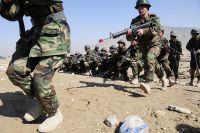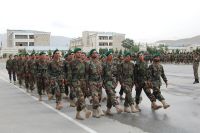In the past ten months there has been measured progress in the Afghan National Security Force (ANSF); in quality as well as quantity. Since last November, NATO Training Mission Afghanistan has supported the Afghan Ministries of Interior and Defense to recruit, train and assign over 100,000 soldiers and police, an incredible feat. To achieve this, the training capacity was increased, moving from under 10,000 seats for police training alone to almost 15,000.
 |
| Kabul — Afghan National Army officer trainees run through a building clearing exercise at the Kabul Military Training Center Source: NATO Click to enlarge |
Quality improved, as well. The instructor to trainee ratio decreased from 1:76 to 1:29, greatly increasing the ability of trainers to give attention to individuals. Improvements like this led to an improved basic rifle qualification rate; increasing from an embarrassing 35% to 97%. To truly professionalize the force, however, will require even more attention to quality in the force – and trainers with specialized skills are required to accomplish this.
In order to develop the systems and institutions that are required to continue to professionalize and grow the ANSF, specialty training is required. Schools that teach skills like acquisitions, logistics, maintenance, intelligence, and even field artillery are needed to balance a currently infantry-centric force. Additionally, leader development courses like the police staff college, police and army officer candidate schools, and various non-commissioned officer development courses are needed. All of these specialty skills require trainers with the requisite skills – trainers that can only be found in the international community. Over the next ten months, our requirement for these trainers will double, with needed skill sets ranging from Mi-17 helicopter pilots and maintainers to doctors, police trainers to instructors at the signal school.
 |
| Afghan National Army soldiers take part in a combined gradution ceremony at the Kabul Military Training Center July 29, 2010 Source: NATO Click to enlarge |
The impacts of not sourcing our trainer requirements are that training base expansions to increase capacity are hindered, specialty school development will be delayed, pace of specialty skills development will be slowed, and the professionalization of the ANSF will be hampered. Essentially, the process of transition to the ANSF will be delayed; as the Secretary General of NATO said recently, “no trainers, no transition.”
If we do not resource the training mission in Afghanistan, we will not be able to achieve our goals for increased quantity and improved quality. We must not allow that to happen. We need to sustain the momentum we have achieved in the past ten months so that we capitalize on our achievements thus far. To create Afghan capacity that is enduring and self-sustaining we must professionalize the police, army, and air forces; create viable logistics and medical systems; and improve the infrastructure and the institutions that train and educate them…above all, we MUST have the trainers to develop them.
Lieutenant General William B. Caldwell, IV
Commander, NATO Training Mission – Afghanistan (NTM‑A) / Commander, Combined Security Transition Command – Afghanistan (CSTC‑A)
Source:
Allied Command Operations
NATO

 von
von